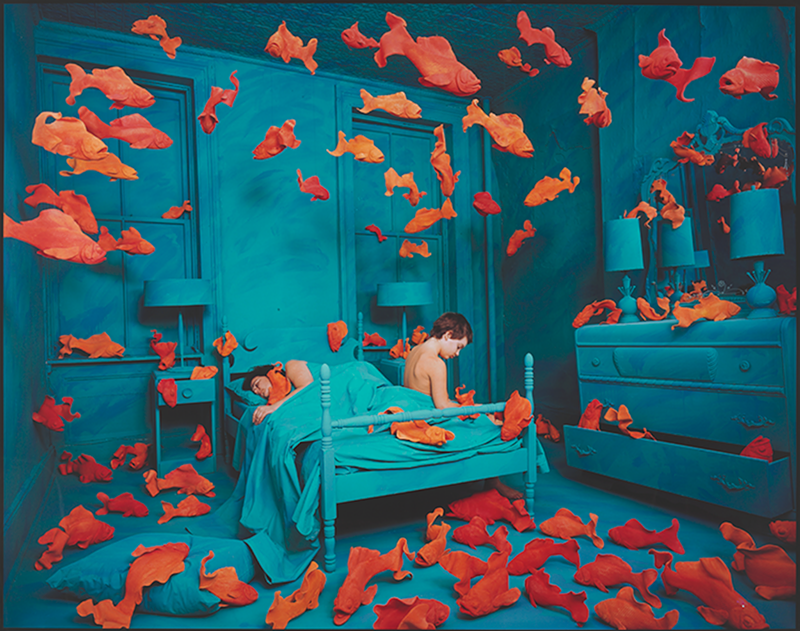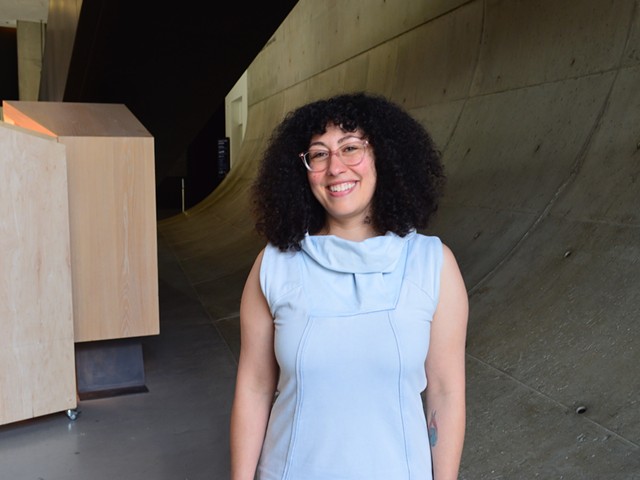
This story is featured in CityBeat's July 12 print edition.
When I received the latest Portico magazine from Taft Museum of Art, I did a double-take. There was a color photograph of one of artist Sandy Skoglund’s unforgettable installations on the cover.
The installation depicted a turquoise bed (with two youths in it; one asleep, the other sitting) in a similarly turquoise bedroom with glowingly orange goldfish all around — in the air, on the floor, inside open drawers, atop window frames, even in the bed. This was her “Revenge of the Goldfish.”
Oh my god! Was a Skoglund installation coming to the Taft Museum? There will be lines waiting throughout Lytle Park to see that! Her singular room-size installations are as compelling — convey as much of a sense of magic — as those by Yayoi Kusama.
Truthfully, I shouldn’t have jumped to conclusions. After all, her installations don’t use models. The source material for Portico’s cover photograph was itself a photograph — Skoglund creates those, too. And that image was being used to highlight a new traveling show featuring major work by some of the most important photographers ever — Modern Women/Modern Vision: Photographs from the Bank of America Collection. The exhibit is up now through Sept. 10 at the Taft. Skoglund’s 27 ¾-inch by 35 ½-inch “Revenge of the Goldfish” has pride of place; it’s the initial photograph in the exhibition, occupying its own wall.
This is impressive, considering who else has distinguished color or black-and-white photographs in this show: Diane Arbus, Dorothea Lange, Cindy Sherman, Hilla Becher (with husband and photographic partner Bernd), Imogen Cunningham and many more. They, along with Skoglund and the others, make Modern Women/Modern Visions an exceedingly memorable and educational show to see.
But Skoglund’s placement in the exhibit also raises questions. You might figure her three-dimensional installations rank first in the hierarchy of her work — without them, there’d be nothing to photograph. You could thus also think her photographs function primarily as documentation, a way for us to see her work when we can’t travel to see the rooms. The “Revenge of the Goldfish” installation is owned by the Smith College Museum of Art, where it is currently off view.
The Dayton Art Institute, by the way, owns Skoglund’s 1998 “Shimmering Madness,” which consists of jelly beans, wood, plastic, metal and motors. And back in 1998, four of her installations — including “Revenge of the Goldfish” — came to the Cincinnati Art Museum as part of a retrospective of her work called Reality Under Siege. She also had shown work at the gallery owned by the late Carl Solway, whom she remembers as a “great, amazing art dealer.”
Decades ago, Skoglund decided to prepare photographs of her installations with the same kind of careful planning, design awareness and inventive flair that went into her three-dimensional work. And in the art world, they’ve been accepted as such. The “Revenge of the Goldfish” image in the Bank of America collection is identified as an artist’s print, the seventh in an edition of 30.
“I’m gratified the photographs have taken on so much life,” Skoglund says, in a phone interview from her New Jersey home.
In an email, Skoglund described the meticulous process she uses to create a photograph of one of her installations. She began photographing them in 1979, and estimates she has done 20 such images to date.
First she comes up with the concept for an installation, then she creates or otherwise obtains “all things required for the image,” she explains in an email. “The room looks chaotic with stuff everywhere. This first process takes anywhere from 6 months to a year or more.
“Then I place the camera in the studio,” she continues. “Everything gets moved away from in front of the camera. There is nothing in front of the camera except the walls of the room and the floor of the room.
“The next process is to place things in front of the camera and to slowly make the image while looking through the camera. The camera never moves during this. While I am working on the image I am also thinking about where the models can go.”
One of the most striking things of Skoglund’s long, fruitful career is that, after graduating with an MFA degree in painting from the University of Iowa in 1972, she found herself deeply attracted to conceptualism. There, the idea behind artwork — including photography — can be more powerful and important than the craftsmanship involved in creating a physical object. Often, the resultant conceptual work is also minimalist. That seems a long way from her process now.
A particularly important influence was the artist Ed Ruscha, who in 1970 published a small-press photography book called Real Estate Opportunities. The images, not obviously identifiable as fine art, were of seemingly inconsequential Los Angeles properties for sale. It perhaps was meant as commentary on the blandness of the city’s expansion — in a larger way, of the soulless expansion of all big cities.
“Why would this type of photography be in the art world,” Skoglund asks in our interview. “This work really had no redeeming pictorial characteristics or effort toward a beautiful composition, yet its roots to me were very sophisticated and very interesting — very odd and peculiar thought processes.
“I decided to (pursue) the odd idea,” she continues. “Questions like why make a fish and why so many fish became not very meaningful to me. More interesting was to just put them in front of a camera.”
As much as conceptualism was an influence on Skoglund, she ultimately rejected it as an approach for her. In a sense, she found its approach of “emptying out and purifying” the creation of art until it’s mostly just an idea that had played itself out.
“By the time I got to New York and was inundated with this very strong conceptual view, I could not see where it could go,” she says.
So she kept the love for the odd idea but paired it with something she appreciated from her painting background — beauty.
“I think in my work it’s not the idea that matters,” she says. “In my work, it’s the beauty — the sheer color bombardment; the visual pleasure, hopefully.”
So you should want to see Skoglund’s “Revenge of the Goldfish” photograph at Taft Museum’s Modern Women/Modern Visions exhibit. And, given its prominence, you definitely won’t miss it. But keep one thing clear when viewing it — this is not documentation. It is a beautiful, carefully created artwork.
Modern Women/Modern Vision: Photographs from the Bank of America Collection will be on display at the Taft Museum of Art through Sept. 10. Info: taftmuseum.org.
Subscribe to CityBeat newsletters.
Follow us: Apple News | Google News | NewsBreak | Reddit | Instagram | Facebook | Twitter | Or sign up for our RSS Feed





